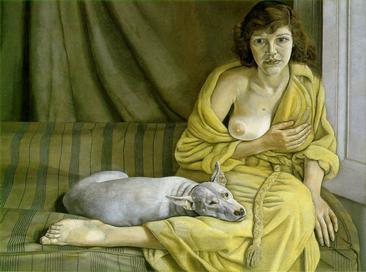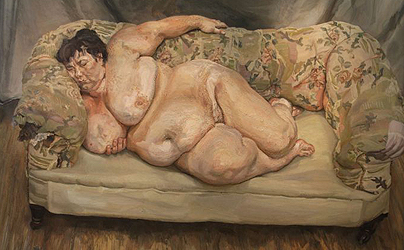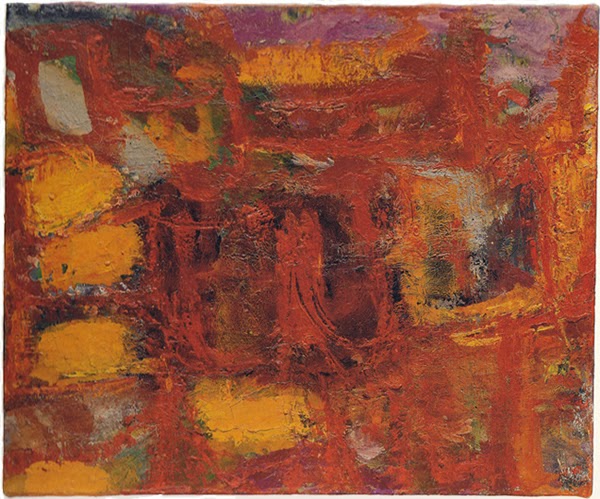Lucian Freud
Lucian Freud
Box of apple in Wales 1939
Fragment of Head of Gerald Wild 1943
Horse Smiling 1939-1940
Landscape with birds 1940
Evacuee Boy 1942
Man with a Feather 1943
Memory of London 1939
Stephen Spender 1940
The Village Boys 1942
Nipote di Sigmund Freud, è figlio dell'architetto Ernst Freud e padre della scultrice Jane MacAdam Freud. Nel 1933, poco dopo l’ascesa al potere in Germania di Adolf Hitler, si trasferisce nelRegno Unito con genitori e fratelli, ottenendo qualche anno più tardi la naturalizzazione britannica.
Risale al 1937 la sua unica scultura, che gli vale l'ammissione alla Central School of Arts and Crafts di Londra prima, per iscriversi poi alla East Anglian School of Drawings and Paintings diDedham nell'Essex diretta dal pittore Cedric Morris, che fu il suo primo mentore. I suoi studi vengono interrotti per un servizio su un convoglio di navi da guerra nell'Atlantico settentrionale.
Le prime prove pittoriche di Freud tendono all'espressività intensa, deformano volti e oggetti in direzione della Nuova oggettività ma forse anche tengono in vista Chagall surnaturel. Dai primi passi del suo cammino d'artista, Freud palesa uno straordinario spirito di osservazione del reale e una forte adesione concettuale ad esso, che si farà con gli anni sempre più incisiva.
Tiene la sua prima personale nel 1944, ma già dieci anni dopo rappresenta la Gran Bretagna alla XXVII Biennale di Arti Visive di Venezia a fianco di Francis Bacon (pittore con il quale manterrà una certa affinità di ricerca) e Ben Nicholson.
A partire dalla fine degli anni Cinquanta, Freud abbandona il disegno come attività principale e indipendente e il disegno anche intenso come struttura che governa il dipinto. Il suo nuovo stile muove da una nuova diversa maniera di vedere, il suo sguardo si volge anche all'interno dell'essere umano.
Nel 1951 al Festival of Britain è premiato con Arts Council Prize. 1953-1954 è visitor professor alla Slade School of Fine Art di Londra.
Nel 1983 gli viene conferita l'onorificenza di "Companion of Honour". È Accademico Emerito dell’Accademia delle Arti del Disegno nella Classe di Pittura.
Muore nella sua casa londinese, all'età di ottantotto anni, dopo una breve malattia, il 21 luglio 2011[1].
Early life and family[edit]
Born in Berlin, Freud was the son of a German Jewish mother, Lucie (née Brasch), and an Austrian Jewish father, Ernst L. Freud, an architect.[4][5] He was a grandson of Sigmund Freud, and elder brother of the broadcaster, writer and politician Clement Freud (thus uncle of Emma and Matthew Freud) and the younger brother of Stephan Gabriel Freud.
He moved with his family to St John's Wood, London, in 1933 to escape the rise of Nazism. He became a British subject in 1939,[4] having attended Dartington Hall School in Totnes, Devon, and later Bryanston School,[6][7] for a year before being expelled due to disruptive behaviour.[8]
Early career[edit]
Freud briefly studied at the Central School of Art in London, and from 1939 with greater success at Cedric Morris' East Anglian School of Painting and Drawing in Dedham, relocated in 1940 to Benton End, a house near Hadleigh, Suffolk. He also attended Goldsmiths' College, part of the University of London, from 1942–3. He served as a merchant seaman in an Atlantic convoy in 1941 before being invalided out of service in 1942.
In 1943, the poet and editor Meary James Thurairajah Tambimuttu commissioned the young artist to illustrate a book of poems by Nicholas Moore entitled "The Glass Tower." It was published the following year by Editions Poetry London and comprised, among other drawings, a stuffed zebra and a palm tree. Both subjects reappeared in The Painter's Room on display at Freud's first solo exhibition in 1944 at the Alex Reid & Lefevre Gallery. In the summer of 1946, he travelled to Paris before continuing to Greece for several months to visit John Craxton.[9] In the early fifties he was a frequent visitor to Dublin where he would share Patrick Swift's studio.[10] In late 1952, Freud and Lady Caroline Blackwood eloped to Paris where they married in 1953. He otherwise lived and worked in London for the rest of his life.
Freud was part of a group of figurative artists that American artist Ronald Kitaj later named "The School of London".[11] This was more a loose collection of individual artists who knew each other, some intimately, and were working in London at the same time in the figurative style (but during the boom years of abstract painting). The group was led by figures such as Francis Bacon and Freud, and included Frank Auerbach, Michael Andrews, Leon Kossoff, Robert Colquhoun, Robert MacBryde, Reginald Gray, and Kitaj himself. He was a visiting tutor at the Slade School of Fine Art of University College London from 1949 to 1954.
Mature style[edit]
Freud's early paintings, which are mostly very small, are often associated with German Expressionism (an influence he tended to deny) and Surrealism in depicting people, plants and animals in unusual juxtapositions. Some very early works anticipate the varied flesh tones of his mature style, for example Cedric Morris (1940, National Museum of Wales), but after the end of the war he developed a thinly painted very precise linear style with muted colours, best known in his self-portrait Man with Thistle (1946, Tate[12] ) and a series of large-eyed portraits of his first wife, Kitty Garman, such as Girl with a Kitten (1947, Tate[13]). These were painted with tiny sable brushes and evoked Early Netherlandish painting.[14]
From the 1950s, he began to work in portraiture, often nudes (though his first full length nude was not painted until 1966),[15] to the almost complete exclusion of everything else, and by the middle of the decade developed a much more free style using large hogs-hair brushes, with an intense concentration of the texture and colour of flesh, and much thicker paint, including impasto. Girl with a white dog, 1951–1952, (Tate) is an example of a transitional work in this process, sharing many characteristics with paintings before and after it, with relatively tight brushwork and a middling size and viewpoint. With this technique, he would often clean his brush after each stroke when painting flesh, so that the colour remained constantly variable. He also started to paint standing up, which continued until old age, when he switched to a high chair.[15] The colours of non-flesh areas in these paintings are typically muted, while the flesh becomes increasingly highly and variably coloured. By about 1960, Freud had established the style that he would use, with some changes, for the rest of his career. The portraits in the new style often used an over life-size scale from the start, but were mostly relatively small heads or half-lengths. Later portraits were often very much larger, and appealed to galleries and collectors. In his late career he often followed a portrait by producing an etching of the subject in a different pose, drawing directly onto the plate, with the sitter in his view.[16]
Freud's portraits often depict only the sitter, sometimes sprawled naked on the floor or on a bed or alternatively juxtaposed with something else, as in Girl With a White Dog (1951–52) and Naked Man With Rat (1977–78).[17] According to Edward Chaney, "The distinctive, recumbent manner in which Freud poses so many of his sitters suggests the conscious or unconscious influence both of his grandfather's psychoanalytical couch and of the Egyptian mummy, his dreaming figures, clothed or nude, staring into space until (if ever) brought back to health and/or consciousness. The particular application of this supine pose to freaks, friends, wives, mistresses, dogs, daughters and mother alike (the latter regularly depicted after her suicide attempt and eventually, literally mummy-like in death), tends to support this hypothesis."[18]
The use of animals in his compositions is widespread, and often he features a pet and its owner. Other examples of portraits with both animals and people in Freud's work includeGuy and Speck (1980–81), Eli and David (2005–06) and Double Portrait (1985–86).[19] He had a special passion for horses, having enjoyed riding at school in Dartington, where he sometimes slept in the stables.[20] His portraits solely of horses include Grey Gelding (2003), Skewbald Mare (2004), and Mare Eating Hay (2006). Houseplants, often not in peak condition, featured prominently in some portraits, especially in the 1960s, and Freud also produced a number of paintings purely of plants.[21] Other regular features included mattresses in earlier works, and huge piles of the linen rags with which he used to clean his brushes in later ones.[22] Some portraits, especially in the 1980s, have very carefully painted views of London roofscapes seen through the studio windows.[23]
Freud's subjects, who needed to make a very large and uncertain commitment of their time, were often the people in his life; friends, family, fellow painters, lovers, children. He said, "The subject matter is autobiographical, it's all to do with hope and memory and sensuality and involvement, really.[24] However the titles were mostly anonymous, and the identity of the sitter not always disclosed; the Duke and Duchess of Devonshire had a portrait of one of Freud's daughters as a baby for several years before he mentioned who the model was. In the 1970s Freud spent 4,000 hours on a series of paintings of his mother, about which art historian Lawrence Gowing observed "it is more than 300 years since a painter showed as directly and as visually his relationship with his mother. And that was Rembrandt."[25]
Painting from life, Freud was apt to spend a great deal of time with one subject, and demanded the model's presence even while working on the background of the portrait. A nude completed in 2007 required sixteen months of work, with the model posing all but four evenings during that time; with each session averaging five hours, the painting took approximately 2,400 hours to complete.[26] A rapport with his models was necessary, and while at work, Freud was characterised as "an outstanding raconteur and mimic".[26] Regarding the difficulty in deciding when a painting is completed, Freud said that "he feels he's finished when he gets the impression he's working on somebody else's painting".[26] Paintings were divided into day paintings done in natural light and night paintings done under artificial light, and the sessions, and lighting, were never mixed.[27]
It was Freud's practice to begin a painting by first drawing in charcoal on the canvas. He then applied paint to a small area of the canvas, and gradually worked outward from that point. For a new sitter, he often started with the head as a means of "getting to know" the person, then painted the rest of the figure, eventually returning to the head as his comprehension of the model deepened.[26] A section of canvas was intentionally left bare until the painting was finished, as a reminder that the work was in progress.[26] The finished painting is an accumulation of richly worked layers of pigment, as well as months of intense observation.[26]
In art critic Martin Gayford's 2010 book, Man with a Blue Scarf: On Sitting for a Portrait by Lucian Freud, Gayford chronicled the forty days he spent with Lucian Freud while sitting for his portrait. Gayford surmised that Freud sought to capture his model's individuality by, as Gayford named it, his "omnivorous" gaze. Gayford also mentions that his final portrait seemed to "reveal secrets—ageing, ugliness, faults—that I imagine...I am hiding from the world..." – suggesting how sharp and penetrating Freud's gaze is.[28]
Later career[edit]
"I paint people," Freud said, "not because of what they are like, not exactly in spite of what they are like, but how they happen to be."[29] Freud painted fellow artists, including Frank Auerbach and Francis Bacon. He produced a series of portraits of the performance artist Leigh Bowery, and also painted Henrietta Moraes, a muse to many Soho artists. A series of huge nude portraits from the mid-1990s depicted the very large Sue Tilley, or "Big Sue", some using her job title of "Benefits Supervisor" in the title of the painting,[30] as in his 1995 portrait Benefits Supervisor Sleeping, which in May 2008 was sold by Christie's in New York for $33.6 million, setting a world record auction price for a living artist.[31][32]
Freud's most consistent model in his later years was his studio assistant and friend David Dawson, the subject of his final, unfinished work.[33] Towards the end of his life he did a nude portrait of model Kate Moss. Freud was one of the best known British artists working in a representational style, and was shortlisted for the Turner Prize in 1989.[34][35][36]
His painting After Cézanne, notable because of its unusual shape, was purchased by the National Gallery of Australia for $7.4 million. The top left section of this painting has been 'grafted' on to the main section below, and closer inspection reveals a horizontal line where these two sections were joined.
In 1996, Abbot Hall Art Gallery in Kendal mounted a major exhibition of 27 paintings and thirteen etchings, covering the whole period of Freud's working life to date. The following year theScottish National Gallery of Modern Art presented "Lucian Freud: Early Works". The exhibition comprised around 30 drawings and paintings done between 1940 and 1945.[37] This was followed by a large retrospective at Tate Britain in 2002. During a period from May 2000 to December 2001, Freud painted Queen Elizabeth II. There was criticism of this portrayal of the Queen in some sections of the British media. The highest selling tabloid newspaper, The Sun, was particularly condemnatory, describing the portrait as "a travesty".[38] In 2005, a retrospective of Freud's work was held at the Museo Correr in Venice scheduled to coincide with the Biennale. In late 2007, a collection of Freud's etchings titled "Lucian Freud: The Painter's Etchings" went on display at the Museum of Modern Art.[39]
Freud died in London on 20 July 2011 and on 27 July was buried in Highgate Cemetery. Archbishop Rowan Williams officiated at the private funeral.
On 13 October 2011, Freud's 1952 Boy's Head, a small portrait of Charlie Lumley, his neighbour, reached $4,998,088 at Sotheby's London Contemporary art evening auction, making it one of the highlights of the 2011 auction autumn season.[40]
Personal life[edit]
Freud is rumoured to have fathered as many as forty children[41] although this number is generally accepted as an exaggeration. Fourteen children have been identified, two from Freud's first marriage and 12 by various mistresses.[42]
After an affair with Lorna Garman, he went on to marry, in 1948, her niece Kathleen "Kitty" Epstein, daughter of sculptor Jacob Epstein and socialite Kathleen Garman. They had two daughters, Annie and Annabel Freud, and the marriage ended in 1952.[43] Kitty Freud, later known as Kitty Godley (after her marriage in 1955 to economist Wynne Godley), died in 2011.[44]
Freud then began an affair with Guinness beer heiress and writer Lady Caroline Blackwood. They married in 1953 and divorced in 1959.[43] She is said to have been the only woman who truly broke his heart. After their divorce, his friends noticed a change in him; he began drinking heavily and getting into fights. Francis Bacon became concerned that he was suicidal.[45][46]
Freud had additional children by the following women:[42]





















Commenti